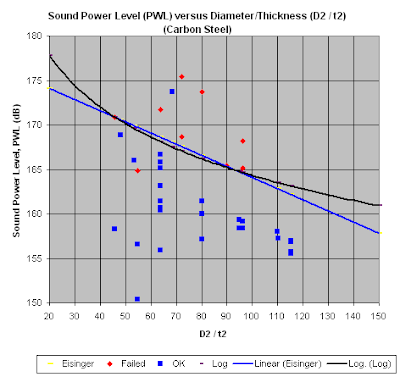Wednesday, April 29, 2009
Display problem ? Click HERE
Recommended :
- Tips on Succession in FREE Subscription
- Subscribes to FREE Hydrocarbon Processing
Sound Power Level (PWL) is the acoustic energy generated by a pressure reduction device. There are several ways to assess the adequacy of the piping to resist AIV fatigue. One of the way to ensure piping downstream of pressure reducing device sufficiently strong to resist AIV fatigue is to ensure the PWL allowable limit of downstream piping higher than the PWL generated by the pressure reducing device. Refer to "Sound Power Level (PWL) Prediction" for equation in prediction PWL.
A piping will have it stiffness and resistivity against vibration. It is very much subject to piping diameter, material properties, wall thickness, distribution of masses, pipe support, etc. Allowable sound power level and/or dynamic stress of piping can be a measurement of this resistivity of piping against excitation due to AIV. Several allowable PWL curves for piping which derived from different method i.e. "D-method", "D/t-method ", "E-method", etc have been used. Besides PWL related method, there are other method i.e. "Dynamic stress method", "Likelihood of Failure (LOF) method", etc which adopting allowable stress level also been used.
"D/t-Method"
Based on data available in Carucci & Mueller (1982) studies, "No failure" and "Failure" points have been plotted in following chart with Sound Power Level (PWL) versus Pipe Diameter / Wall thickness (D/t).
Note :
1) A "failure" point (0.3m, 165dB) is below curve. It is failed on bad welding. No further failure after good welding.
2) Red point are "failure" point and Blue point are "No failure" point
3) May be used for 0.2m < D < 0.9m. Use at risk for D < 0.2m and D > 0.9m
PWL Limit Equation For "D/t-method"
Eisinger (1997) has proposed a PWL limit line (blue line).
PWLlimit = 176.6 - 125 (D/t)
In this post, a new PWL limt line has been derived and following equation representing this line (black line).
PWLlimit = 203 - 8.4 Ln (1000D/t)
where
PWLlimit = Maximum allowable PWL at Pipe diameter D meter, (dB)
D = Pipe diameter, (m)
t = Wall thickness, (mm)
This line may be used to assess potential failure of piping downstream of pressure reducing device. Any point above the line potentially fail on AIV, piping treatment or redesign required to minimise the risk of AIV failure. This will be discussed in future...
There is additional discussion on unclear area and now proposed polynomial PWL limit line. Read more in "Assess AIV with "D/t-method" with Polynomial PWL Limit Line".
Related Topic
- Extra Attention to Common Point and Similarity on AIV Failure
- Piping Excitation When Expose to Acoustic Energy
- Acoustic Induced Vibration (AIV) Fatigue
- Sound Power Level (PWL) Prediction from AIV Aspect
- Several Criteria and Constraints for Flare Network - Piping
- Flow Element (FE) Upstream or Downstream of Control Valve (CV) ?

0 Comments:
Post a Comment
Let us know your opinion !!! You can use some HTML tags, such as <b>, <i>, <a>
Subscribe to Post Comments [Atom]
Home:
<< Home